
Citheronia regalis, the regal moth or royal walnut moth, is a North American moth in the family Saturniidae. The caterpillars are called hickory horned devils. The adult (imago) has a wingspan of 3.75-6.1 in (9.5-15.5 cm). The species was first described by Johan Christian Fabricius in 1793.

Zanclognatha is a genus of litter moths of the family Erebidae. The genus was erected by Julius Lederer in 1857.

Eumacaria is a monotypic moth genus in the family Geometridae described by Packard in 1873. Its only species, Eumacaria madopata, the brown-bordered geometer moth, was first described by Achille Guenée in 1857. It is found in North America, where it has been recorded from British Columbia, northern Washington, southern Saskatchewan, from Maine to Florida, South Dakota, North Dakota, Nebraska, Wyoming, Idaho, Colorado and New Mexico. The habitat consists of orchards and shrublands. The species is listed as threatened in Connecticut.

Catocala badia, the bay underwing, bayberry underwing or old maid, is a moth of the family Erebidae. It is found from southern Maine and New Hampshire south to New York and Connecticut.

Catocala pretiosa, the precious underwing, is a moth of the family Erebidae. The species was first described by Joseph Albert Lintner in 1876. It was included in Catocala crataegi by many authors, but recently it has been revalidated as a distinct species. The subspecies of pretiosa is listed as a species of special concern and believed extirpated in the US state of Connecticut.

Catocala herodias, the Herodias underwing or Gerhard's underwing, is a moth of the family Erebidae. The species was first described by Strecker in 1876. The nominate form is found in the US states of Texas and Oklahoma. Subspecies Catocala herodias gerhardi is found from Massachusetts, Connecticut, New York to Virginia. The gerhardi subspecies is listed as endangered in Connecticut.
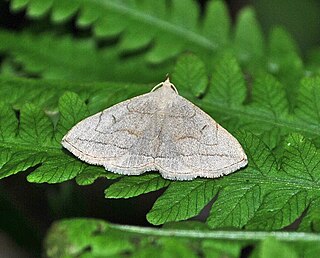
Zanclognatha pedipilalis, the grayish zanclognatha, is a litter moth of the family Erebidae. The species was first described by Achille Guenée in 1854. It is found in eastern North America, from Nova Scotia south to Florida and Mississippi, west to Alberta and Kansas.
Zanclognatha jacchusalis bryanti is a moth of the family Noctuidae. It was described by William Barnes in 1928. It is found from British Columbia to Oregon.
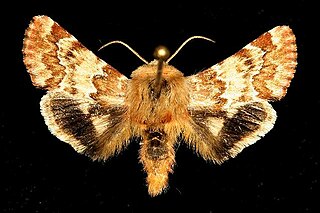
Schinia septentrionalis, the northern flower moth, is a moth of the family Noctuidae. The species was first described by Francis Walker in 1858. It is found in North America from Missouri to Quebec to South Carolina and Louisiana. Records include Colorado, Oklahoma, South Dakota and Texas. It is listed as threatened in the US state of Connecticut.
The fawn brown dart is a moth of the family Noctuidae. It is found in southern Canada and the northern United States from southern Quebec and eastern Massachusetts west to British Columbia and southern Washington. In the Rocky Mountain region it occurs as far south as northern New Mexico, north-eastern Arizona and central Idaho. It is listed as a species of special concern in Connecticut.

Zanclognatha jacchusalis, the wavy-lined zanclognatha, is a litter moth of the family Erebidae. It was described by Francis Walker in 1859. It is found in the US from Wisconsin to Maine, south to Georgia and Louisiana.

Zanclognatha laevigata, the variable zanclognatha, is a litter moth of the family Erebidae. It was described by Augustus Radcliffe Grote in 1872. It is found in North America from Manitoba to Nova Scotia, south to Florida and Missouri.

Zanclognatha lituralis, the lettered zanclognatha, is a litter moth of the family Erebidae. It was described by Jacob Hübner in 1818. It is found from in North America from Wisconsin to Nova Scotia, and south to Florida and Texas.
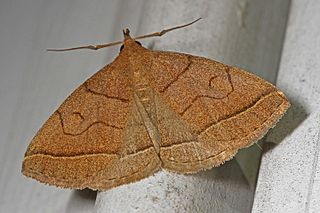
Zanclognatha obscuripennis, the dark zanclognatha, is a litter moth of the family Erebidae. It was described by Augustus Radcliffe Grote in 1872. It is found in North America from Missouri to Quebec, south to Florida and Texas.
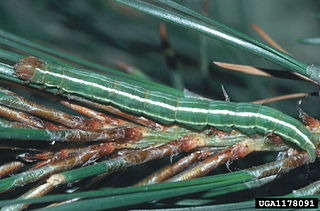
Zale curema, the black-eyed zale or northeastern pine zale, is a moth of the family Noctuidae. The species was first described by John Bernhard Smith in 1908. It is found from New York to Maine, south to western North Carolina, west to the Gulf States and Texas. The species is listed as endangered in Connecticut.
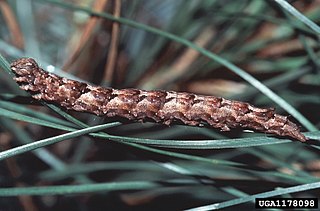
Zale submediana, the gray spring zale, is a moth of the family Noctuidae. The species was first described by Strand in 1917. It is found in the US from Wisconsin to Maine, south to New Jersey and in mountains to North Carolina.
Melitara prodenialis is a moth of the family Pyralidae described by Francis Walker in 1863. It is native to North America, where it is known from south-eastern New York to Florida along the Atlantic coastal plain, and west to eastern Oklahoma and north-central and south-eastern Texas. It is an introduced species in Hawaii. It is a special concern species in Connecticut.
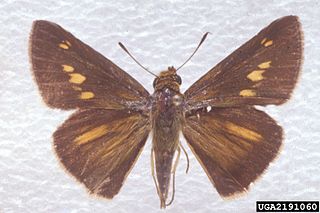
Euphyes dion, the Dion skipper or Alabama skipper, is a species of butterfly of the family Hesperiidae. It is found in scattered populations along the Atlantic coast of North America, from western Massachusetts and south-eastern New York south to north-eastern Florida, west to north-eastern Texas, and north to south-eastern North Dakota, northern Wisconsin, southern Ontario and southern Quebec. It is listed as a species of special concern in the US state of Connecticut.
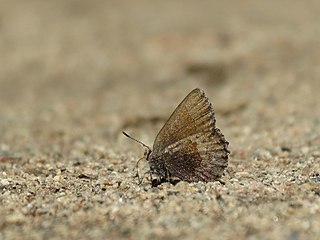
Callophrys polios, the hoary elfin, is a butterfly of the family Lycaenidae. It has a very local distribution in the United States from Maine south to New Jersey and in the Appalachian Mountains to Virginia, west across the Great Lakes states and the southern prairie provinces and north to Alaska. Along the Pacific Coast it is found to northern California and in the Rocky Mountains south to northern New Mexico. It is listed as a species of special concern and believed extirpated in the US state of Connecticut.

Grammia phyllira, the phyllira tiger moth, is a moth of the family Erebidae. It was described by Dru Drury in 1773. It is found in North America from Quebec and New England south to Florida and west to Texas, Colorado and Alberta. The habitat consists of dry, open woodland and grassland. The species is listed as endangered in Connecticut.
















